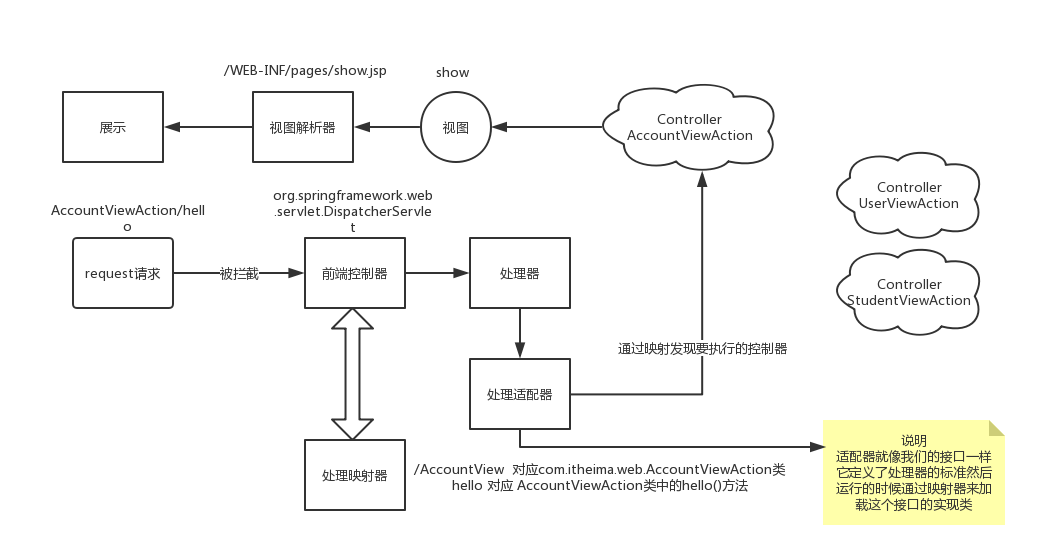SpringMVC第一天
一、内容介绍
1、三层架构和MVC设计模式
2、spring mvc概念
3、spring mvc入门程序
4、入门案例的执行过程及原理分析
5、@RequestMapping注解(重点)
6、参数的绑定(重点)
7、编码过滤器(重点)
二、三层架构和MVC设计模式
a、三层架构
web层-- 表现层: 处理用户的请求和相应
技术:servlet
service层:业务层, 编写业务,处理业务逻辑,编写事务
技术:spring
dao层:持久层,数据的增删改查
技术:jdbcTemplate -- mybatis
b、mvc设计模式
M:model --模型: pojo类,封装数据 , 广义上:dao + service + model = 业务模型层
V:view -- 视图: jsp,html,freemarker:展示数据, 广义上:只要能展示数据就是视图
C:cotroller --控制层:servlet :处理用户的请求和相应
三、springMVC的概念
springMVC是满足了mvc设计的模式的一个表现层框架
四、SpringMVC的入门(重点)
1、引入依赖
<!--spring的核心-->
<dependency>
<groupId>org.springframework</groupId>
<artifactId>spring-context</artifactId>
<version>5.0.2.RELEASE</version>
</dependency>
<!--springMVC的jar包-->
<dependency>
<groupId>org.springframework</groupId>
<artifactId>spring-webmvc</artifactId>
<version>5.0.2.RELEASE</version>
</dependency>
<!-- servlet-api -->
<dependency>
<groupId>javax.servlet</groupId>
<artifactId>servlet-api</artifactId>
<version>2.5</version>
<!--
maven 项目执行分为三个阶段
编译(需要) 测试(需要) 运行(不需要)
provided : 编译器生效,测试生效,运行不生效
servlet-api ,jsp-api:这两个包,需要配置依赖范围为provided ,其他都不需要
-->
<scope>provided</scope>
</dependency>
<dependency>
<groupId>javax.servlet</groupId>
<artifactId>jsp-api</artifactId>
<version>2.0</version>
<scope>provided</scope>
</dependency>
关于 <scope>provided</scope>的应用:
由于tomcat中也有这两个包,于是会发生冲突报错
所以加上依赖范围,编译测试用自己的包,运行用tomcat的包
具体可见 关于maven依赖中的provided使用
2、spring-mvc.xml配置
<?xml version="1.0" encoding="UTF-8"?>
<beans xmlns="http://www.springframework.org/schema/beans"
xmlns:xsi="http://www.w3.org/2001/XMLSchema-instance"
xmlns:context="http://www.springframework.org/schema/context"
xsi:schemaLocation="http://www.springframework.org/schema/beans http://www.springframework.org/schema/beans/spring-beans.xsd http://www.springframework.org/schema/context http://www.springframework.org/schema/context/spring-context.xsd">
<!--开启注解,扫描包-->
<context:component-scan base-package="com.itheima"></context:component-scan>
<!--视图解析器-->
<bean class="org.springframework.web.servlet.view.InternalResourceViewResolver">
<property name="prefix" value="/WEB-INF/"></property>
<property name="suffix" value=".jsp"></property>
</bean>
<!--mvc的注解驱动:加载了springmvc的映射器、处理器等等-->
<mvc:annotation-driven></mvc:annotation-driven>
</beans>
3、web.xml配置
<!--配置servlet:前端控制器-->
<servlet>
<servlet-name>DispatcherServlet</servlet-name>
<servlet-class>org.springframework.web.servlet.DispatcherServlet</servlet-class>
<!--servlet中配置初始化参数,用于读取 SpringMVC 的配置文件-->
<init-param>
<param-name>contextConfigLocation</param-name>
<param-value>classpath:spring-mvc.xml</param-value>
</init-param>
<!-- 配置 servlet 的对象的创建时间点:
在启动tomcat时创建servlet对象,如果不创建 在第一次访问servlet时创建
取值只能是非 0 正整数,表示启动顺序 -->
<load-on-startup>1</load-on-startup>
</servlet>
<servlet-mapping>
<servlet-name>DispatcherServlet</servlet-name>
<!--
/ 拦截所有的请求: 包括http请求, 静态资源请求:img,js ,css
/* 拦截请求:不包含静态资源
*.do , *.action : 拦截以 .do, .action结尾的请求, 默认拦截.action
-->
<url-pattern>/</url-pattern>
</servlet-mapping>
4、自定义核心控制类
@Controller
public class TestController {
@RequestMapping("/test")
public void test(){
System.out.println("helloWorld--测试成功");
}
}
5、页面配置
<!-- 第一种访问方式 -->
<a href="${pageContext.request.contextPath}/test">请求1</a>
<!-- 第二种访问方式 -->
<a href="test">请求2</a>
在 jsp 中第二种写法时,不要在访问 URL 前面加/,否则无法找到资源。
五、入门案例的执行过程及原理分析
 执行流程参照:springMVC请求流程详解
执行流程参照:springMVC请求流程详解
DispatcherServlet(前端控制器):
用户请求到达前端控制器,它就相当于 mvc 模式中的 c,dispatcherServlet 是整个流程控制的中心,由它调用其它组件处理用户的请求,dispatcherServlet 的存在降低了组件之间的耦合性。
HandlerMapping(处理器映射器):返回一个执行链
HandlerMapping 负责根据用户请求找到 Handler 即处理器,SpringMVC 提供了不同的映射器实现不同的映射方式,例如:配置文件方式,实现接口方式,注解方式等。
Handler(处理器):也是我们编写的controller
它就是我们开发中要编写的具体业务控制器。由 DispatcherServlet 把用户请求转发到 Handler。由Handler 对具体的用户请求进行处理。
HandlAdapter(处理器适配器):
HandlerAdapter 对处理器进行执行,通过扩展适配器可以对更多类型的处理器进行执行。
六、@RequestMapping注解(重点)
- @RequestMapping 请求路径映射,该注解可以标记在方法上,也可以标记在类上
类上:
请求 URL 的第一级访问目录。此处不写的话,就相当于应用的根目录。
方法上:
请求 URL 的第二级访问目录。
@RequestMapping("/account")
public class AccountController {
@RequestMapping("/findAccount")
public String findAccount() {}
}
- 属性
path:指定请求路径,别名value,所以属性名可以省略
method: 请求方式:
get: 路径和超链接请求都是get请求
post: 必须在表单中实现
params:声明请求路径的规则 -- 了解
"name":路径中必须有name
"age>20":路径中必须有age>20
"!name" :路径中不存在name
@RequestMapping(value = "/hello",method = RequestMethod.POST,params = {"!name","age>20"})
public String hello(){}
七、参数的绑定(重点)
- 表单中提交的name值与方法中的参数(简单类型)名称一致,就可以直接获取到
- 方法的参数:pojo类型
只要保证表单提交的name值与pojo的属性名一致,就可以封装数据
<form action="${pageContext.request.contextPath}/user/saveUser" method="post">
用户名: <input type="text" name="username"> <br>
list集合参数: <input type="text" name="list[0]">
<input type="text" name="list[1]"><br>
一个角色对象:<input type="text" name="role.id">
<input type="text" name="role.roleName"><br>
多个角色对象:<input type="text" name="roleList[0].id">
<input type="text" name="roleList[0].roleName">
<input type="text" name="roleList[1].id">
<input type="text" name="roleList[1].roleName">
map集合:<input type="text" name="map[one]">
<input type="text" name="map[two]">
<input type="text" name="map[three]">
<input type="submit" value="提交">
</form>
- @RequestParam:请求参数绑定,name与参数名不一致
属性: value, name可以指定页面表单中的name值
requird: 是否必须的 , false :不必要的(可有可无);true:必须有该参数
defaultValue: 默认值,如果页面传参了,则使用页面传参的值,如果没有指定,则使用默认值
@RequestMapping("/testParam2")
public String testParam2(@RequestParam(value = "username",required = false,defaultValue = "rose") String name){
System.out.println(name);
return "show";
}
- 特殊情况:(自定义类型转换器)要转换类型是Date类型(了解)
/**
*
* 自定义类型转换器
* 将字符串格式转换为日期格式
* 1. 实现接口converter<S,T>
* S:源类型 -- String
* T:目标类型-- Date
*/
public class StringToDateConverter implements Converter<String ,Date>{
/**
* 类型转换方法
* @param source 源
* @return 目标
*/
@Override
public Date convert(String source) {
//日期类型的转换对象
SimpleDateFormat sdf = new SimpleDateFormat("yyyy/MM/dd");
Date date = null;
try {
date = sdf.parse(source);
} catch (ParseException e) {
e.printStackTrace();
}
return date;
}
}
在springmvc.xml文件中配置类型转换工厂
<!--类型转换工厂-->
<bean id="conversionService" class="org.springframework.context.support.ConversionServiceFactoryBean">
<property name="converters">
<set>
<bean class="com.itheima.converter.StringToDateConverter"></bean>
</set>
</property>
</bean>
在注解驱动中引入类型转换工厂
<!--注解驱动: 关联类型转换工厂-->
<mvc:annotation-driven conversion-service="conversionService"></mvc:annotation-driven>
八、编码过滤器(重点)
web.xml
<!--编码过滤器-->
<filter>
<filter-name>CharactorEncoding</filter-name>
<filter-class>org.springframework.web.filter.CharacterEncodingFilter</filter-class>
<!--配置初始化参数,指定编码格式:拦截的是post请求-->
<init-param>
<param-name>encoding</param-name>
<param-value>utf-8</param-value>
</init-param>
<!--
指定请求编码格式和响应编码格式: 了解,一般不用指定
-->
<init-param>
<param-name>forceEncoding</param-name>
<param-value>true</param-value>
</init-param>
</filter>
<filter-mapping>
<filter-name>CharactorEncoding</filter-name>
<!--拦截所有的请求:不包含静态资源的-->
<url-pattern>/*</url-pattern>
</filter-mapping>
最后
以上就是妩媚翅膀最近收集整理的关于springMVC第一天笔记的全部内容,更多相关springMVC第一天笔记内容请搜索靠谱客的其他文章。








发表评论 取消回复